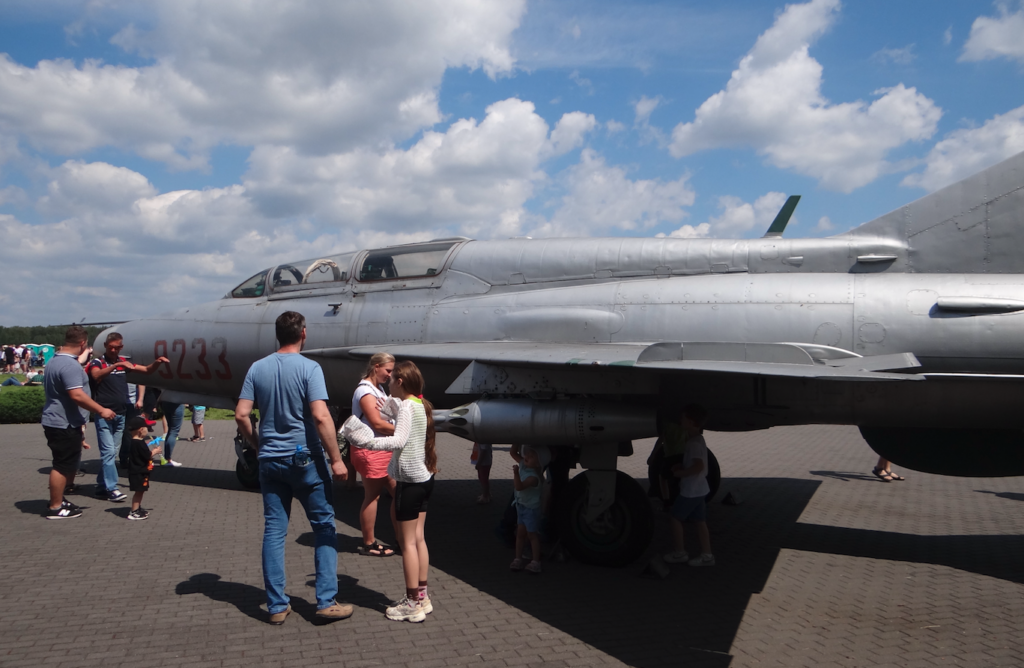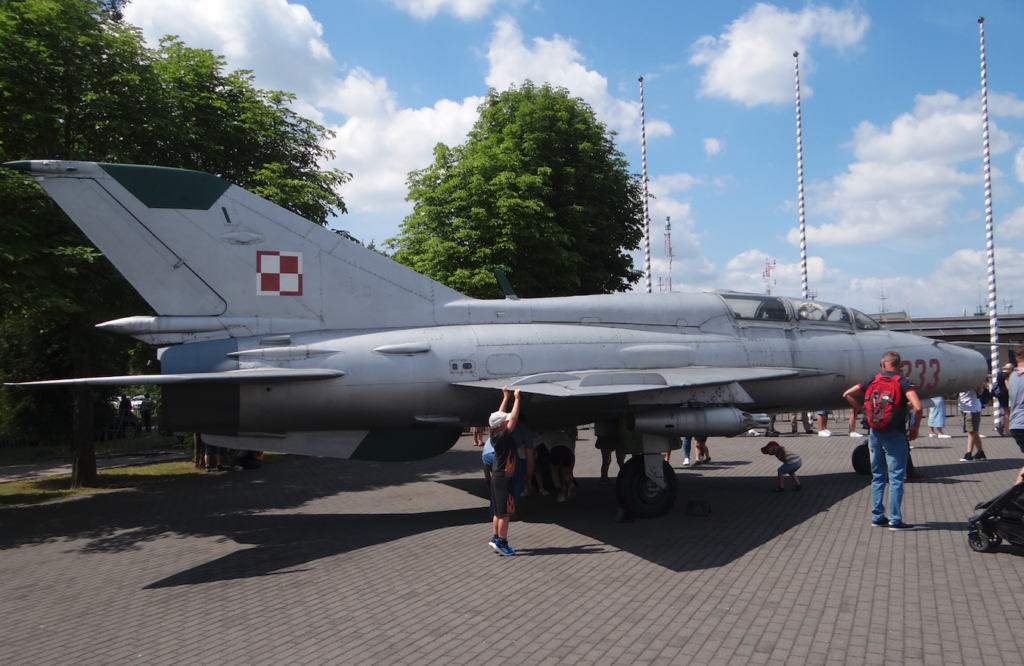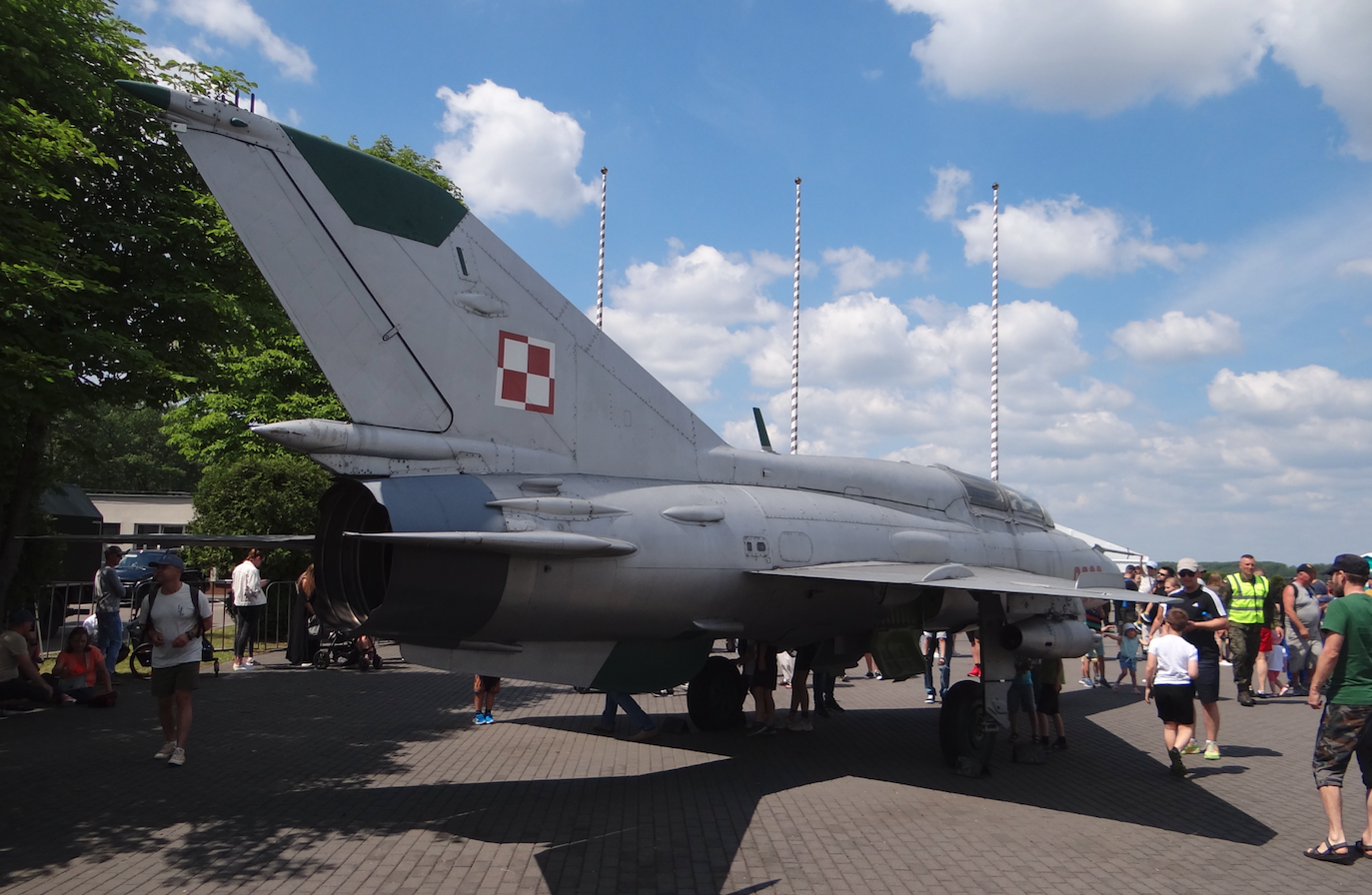Mińsk Mazowiecki 2024-12-09
Mikojan and Guriewicz MiG-21 UM nb 9233.
Supersonic trainer aircraft used in the Polish Army.




History.
The large number of single-seat MiG-21 fighters forced Poland to purchase trainer versions. Poland purchased three trainer versions; MiG-21 U, MiG-21 US, MiG-21 UM. It must be remembered that the training versions of combat aircraft in the CCCP always had the ability to perform combat tasks, although to a very limited extent. This was mainly due to the need to maintain the appropriate weight of the aircraft. In other words, they were not fitted with radar sights. For the MiG-21 in the training-combat version, the pilots’ seats were placed in a tandem configuration. The first cockpit was always occupied by a student. The second cockpit was occupied by an instructor. The first MiG-21 U was delivered to Poland on 18 May 1965, i.e. at a time when two combat versions were already in service; MiG-21 F-13, MiG-21 PF.
MiG-21 U.
In the Moscow state, the large number of fighters built caused the need to provide the army with a two-seater version. The MiG-21 F-13 (type 74) served as the basis for the two-seater version. The E-6 U (uczebny) prototype made its first flight on October 17, 1960. The pilot was Major Ostapenko. The seats were arranged in tandem. The canopy consists of a fixed windshield with three windows and a fairing with two windows, opened individually to the right. The fuel system capacity was 2,350 liters. The central fuel filler was located at the very top, just behind the pilots’ cabin. The aircraft was devoid of firearms, but a 12.7 mm machine gun with a supply of 60 rounds was located in a container suspended under the fuselage. The container could be mounted interchangeably with an additional fuel tank. The weight of the suspended weapons was reduced to 250 kg. The aircraft received an SPU-7 on-board telephone and a damage simulation device. The aircraft in production was designated MiG-21 U (type 66, 66-400). The aircraft was produced in Tbilisi for the needs of the CCCP in 1962-1966, and for export in 1964-1968. In Moscow, a hybrid MiG-21 U (type 66, 66-600) was produced with an enlarged vertical tail and a braking parachute at the base of the stabilizer.
Polish MiG-21 U aircraft. 1965.
For the Polish Army, training and combat versions were imported for training purposes. First, these were the MiG-21U (66-400) versions imported in May and June 1965. A total of 6 units were purchased. One aircraft was transferred to the 41st PLM in Malbork. The remaining 5 aircraft were operated at Poznań Krzesiny Airport.
Along with the purchase of the MiG-21 PFM aircraft, 5 MiG-21 U (66-600) machines were purchased. The first of these aircraft entered service on July 8, 1966. Already from 1967, the aircraft were transferred to some Fighter Aviation Regiments, for example to Zegrze and Goleniów. The withdrawal from service of the first 3 aircraft took place in December 1989, and the last 2 aircraft were withdrawn in February 1990.
In 1969, the 10th PLM in Łask received its first Spark. Spark – this is what the Soviet jargon called a two-seater, two-control aircraft. The 26th PLM received a MiG-21 U type 66-400 aircraft, no. 161220, which was accepted on November 7, 1969. By 1980, the 10th PLM received 5 more MiG-21 U aircraft, including the MiG-21 U type 66-600 version. The last 2 MiG-21 U aircraft were withdrawn in February 1990 and transferred to museums in Krakow and Drzonów.
MiG-21 US.
The MiG-21 US variant belongs to the second generation of MiG-21 aircraft. A training and combat version for aircraft with an air blower on the flaps, designated SPS. Therefore, the aircraft was marked with the letter “S”. In addition to the air blower installation and the appropriate engine, the aircraft received; in the first cabin, an ejection seat KM-1 U, and in the second, KM-1 I; an opening periscope for the instructor KKO-5 with mirrors made of polished metal; an enlarged tank on the fuselage of the aircraft. The total capacity of the fuel installation was 2,450 liters. MiG-21 US aircraft were produced in Tbilisi, in the period 1966-1970 for the army of the Moscow state and for export.
Polish MiG-21 US aircraft.
MiG-21 US combat trainer aircraft were purchased for training fighter pilots of the combat version of the MiG-21 M aircraft. The first aircraft entered service on 28 August 1969. The last one was delivered on 25 July 1970. A total of 12 MiG-21 US aircraft were purchased. Two of these aircraft were delivered to the 41st PLM in Malbork. The aircraft received KM-1 U and KM-1 J ejection seats.
In 1989, the 1st PLM in Mińsk Mazowiecki ended the operation of MiG-21 U combat trainer aircraft, which is why the regiment received 6 MiG-21 US combat trainer aircraft from the 62nd PLM Krzesiny.
During the service of the MiG-21 US aircraft, only one disaster occurred. The tragedy occurred in the 62nd PLM in Krzesiny. On June 7, 1977, in the crash of the MiG-21 US nb 4609 no. 09685146, the pilots died; Colonel Antoni Babkiewicz and Colonel Romuald Rejewski. At the crash site, in 2001, a commemorative boulder with a plaque and two crosses were placed.
MiG-21 UM.
For the needs of training pilots of the third and fourth generation of MiG-21 fighters, the MiG-21 UM type 69, E-6 UM training and combat version was developed. These machines were produced in Tbilisi in the period 1971-1982. A total of 1,133 MiG-21 UM aircraft were built, for the army of the Moscow state and for export.
Polish MiG-21 UM aircraft.
This was the last training and combat version of the MiG-21 aircraft purchased by Poland. The first aircraft arrived in Poland on July 26, 1971. Deliveries of the aircraft were made in two periods. In the period 1971-1975 and in the period 1980-1981. The second delivery was used to train pilots of the last combat version of the MiG-21 bis purchased by Poland. In 1971, the first two MiG-21 UM aircraft were received by the 41st PLM from Malbork. Poland bought a total of 54 MiG-21 UM aircraft.
The Polish MiG-21 UM type 69 aircraft were equipped with the AP-155 autopilot, instead of the KAP-2 used until then. Externally, the aircraft received 4 attachments for weapons and additional fuel tanks.
In the period from January 1980 to May 1981, the second batch of MiG-21 UM training and combat aircraft was imported to Poland. There were 34 units. The aircraft were mainly delivered to units that received MiG-21 bis aircraft. The aircraft were also part of the equipment of the 11th PLM from Wrocław, from which they were also transferred to the 62nd PLM in Krzesiny.
The last documented flight of this type was recorded in the 41st ELT in Malbork. The flight was performed on December 19, 2003, in the MiG-21 UM nb 9323 no. 516999323. The pilots were; Colonel Eugeniusz Garbas (commander of the 22nd Blot) and Lieutenant Colonel Jan Rajchel (commander of the 41st ELT). This last flight was preceded by a flight of the MiG-21 UM, for aerial weather reconnaissance. It was performed by Lieutenant Colonel Jan Drąg and Major Robert Dziadczykowski. During the service, 4 MiG-21 UM aircraft were lost in crashes and 1 as a result of failures.
MiG-21 UM nb 9233.
MiG-21 UM nb 9233, serial number 516999233. Delivered in 1980. It was the 24th MiG-21 UM version delivered to Poland. It served in the Babie Doły Navy. It ended its service in Łask in 2003. In 2006, it was transferred as an exhibit to the 23rd Blot in Mińsk Mazowiecki. The aircraft is presented to the public during Air Show events.
Written by Karol Placha Hetman

